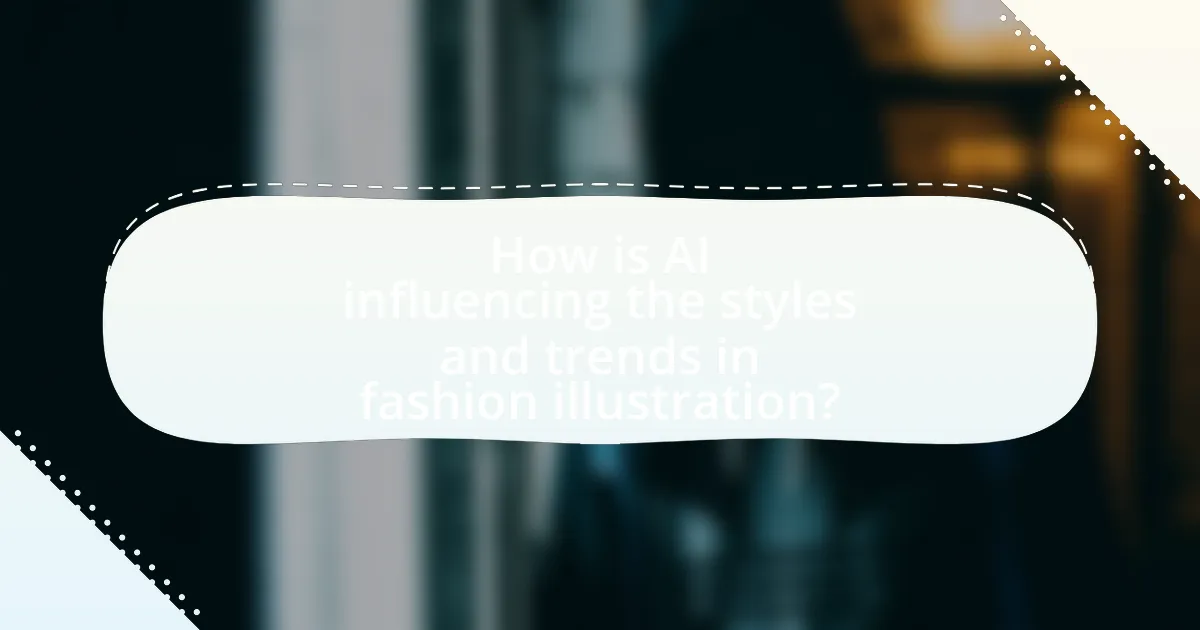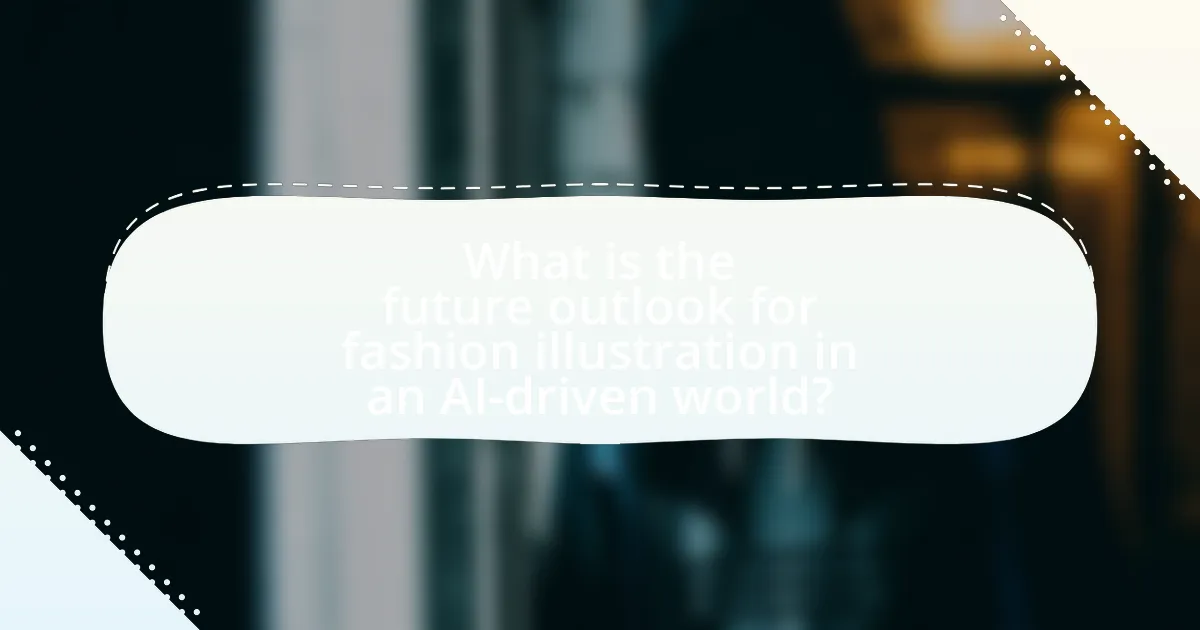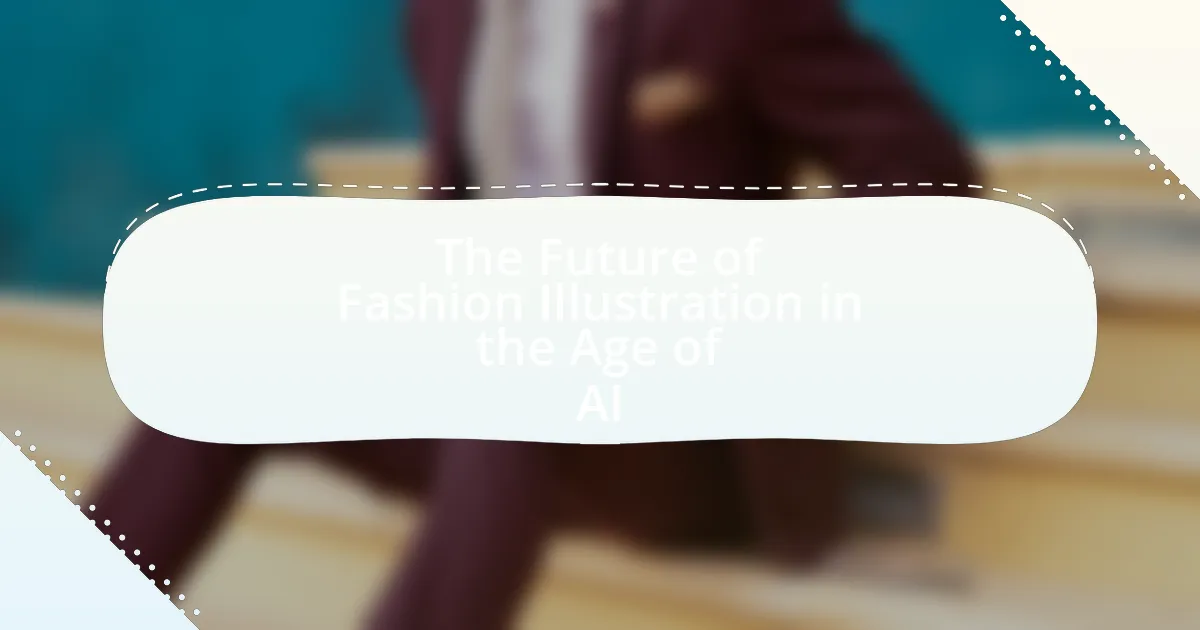The article examines the future of fashion illustration in the context of artificial intelligence (AI), highlighting the collaboration between human artists and AI technologies that enhances creativity and streamlines design processes. It discusses how AI tools automate traditional illustration methods, analyze fashion trends, and generate unique designs, thereby transforming the creative landscape. Key challenges include preserving artistic identity and addressing ethical concerns related to copyright and bias. The article also explores the evolving role of fashion illustrators, the skills needed to thrive alongside AI, and practical steps for integrating AI into their workflows.

What is the Future of Fashion Illustration in the Age of AI?
The future of fashion illustration in the age of AI is characterized by increased collaboration between human artists and AI technologies, leading to innovative design processes and enhanced creativity. AI tools can generate designs, analyze trends, and assist illustrators in refining their work, thereby streamlining the creative workflow. For instance, AI algorithms can analyze vast datasets of fashion trends and consumer preferences, enabling illustrators to create more relevant and appealing designs. This integration of AI not only enhances efficiency but also allows for a broader exploration of styles and concepts, ultimately transforming the landscape of fashion illustration.
How is AI transforming traditional fashion illustration?
AI is transforming traditional fashion illustration by automating design processes and enhancing creativity through advanced algorithms. These algorithms can generate unique designs based on existing styles, allowing illustrators to explore new aesthetics quickly. For instance, AI tools like DeepArt and Runway ML enable artists to create illustrations by simply inputting parameters or images, significantly reducing the time spent on manual sketching. Additionally, AI can analyze trends and consumer preferences, providing illustrators with data-driven insights that inform their work. This integration of technology not only streamlines the illustration process but also opens up new avenues for artistic expression, making fashion illustration more dynamic and responsive to market demands.
What technologies are driving AI advancements in fashion illustration?
AI advancements in fashion illustration are primarily driven by machine learning algorithms, generative adversarial networks (GANs), and computer vision technologies. Machine learning algorithms analyze vast datasets of fashion images to identify trends and styles, enabling the creation of unique illustrations. GANs facilitate the generation of new designs by having two neural networks compete against each other, resulting in high-quality, original artwork. Computer vision technologies enhance the ability to interpret and replicate intricate details in fashion illustrations, allowing for more accurate and realistic representations. These technologies collectively contribute to the evolution of fashion illustration by automating processes and expanding creative possibilities.
How do AI tools enhance the creative process for illustrators?
AI tools enhance the creative process for illustrators by automating repetitive tasks and providing innovative design suggestions. These tools, such as generative design software and AI-driven image editing applications, allow illustrators to focus more on conceptualization and creativity rather than technical execution. For instance, AI can analyze existing artwork and generate new styles or variations, enabling illustrators to explore diverse aesthetics quickly. Additionally, AI algorithms can assist in color selection and composition, streamlining the workflow and improving efficiency. Studies have shown that illustrators using AI tools report increased productivity and enhanced creative output, demonstrating the significant impact of technology on artistic processes.
What challenges do fashion illustrators face with AI integration?
Fashion illustrators face significant challenges with AI integration, primarily concerning the preservation of artistic identity and originality. As AI tools become more prevalent in the creative process, illustrators risk losing their unique style and personal touch, which are essential for distinguishing their work in a competitive market. Additionally, the reliance on AI can lead to a devaluation of traditional skills, as clients may prioritize speed and cost-effectiveness over artistic quality. This shift can undermine the livelihood of illustrators, as seen in industries where automation has replaced human creativity, leading to job displacement. Furthermore, ethical concerns arise regarding copyright and ownership of AI-generated content, complicating the relationship between technology and artistic expression.
How does AI impact the job market for fashion illustrators?
AI significantly alters the job market for fashion illustrators by automating design processes and enhancing creative capabilities. Automation tools can generate illustrations quickly, reducing the demand for traditional hand-drawn work. For instance, AI software like Adobe’s Sensei can assist illustrators in creating designs more efficiently, allowing them to focus on higher-level creative tasks. Additionally, AI-driven platforms can analyze fashion trends and consumer preferences, enabling illustrators to tailor their work more effectively to market demands. This shift may lead to a decrease in entry-level positions while increasing the need for illustrators who can leverage AI tools creatively.
What ethical considerations arise from using AI in fashion illustration?
The ethical considerations arising from using AI in fashion illustration include issues of copyright, authenticity, and the potential for bias. Copyright concerns emerge as AI-generated illustrations may inadvertently replicate existing designs, leading to legal disputes over intellectual property rights. Authenticity is questioned when AI creates works that may mislead consumers about the origin and creativity behind the designs, potentially undermining the value of human artistry. Additionally, bias can manifest in AI algorithms, which may reflect and perpetuate existing stereotypes or exclude diverse representations in fashion, thereby impacting inclusivity within the industry. These considerations highlight the need for careful regulation and ethical guidelines in the integration of AI technologies in fashion illustration.

How is AI influencing the styles and trends in fashion illustration?
AI is significantly influencing styles and trends in fashion illustration by enabling artists to create more diverse and innovative designs through advanced algorithms and machine learning techniques. These technologies allow for the rapid generation of unique visual styles, blending traditional techniques with modern aesthetics, which enhances creativity and expands the range of artistic expression. For instance, AI tools like DALL-E and Midjourney can produce illustrations based on textual descriptions, allowing designers to visualize concepts that may not have been possible through manual illustration alone. This shift not only streamlines the creative process but also democratizes fashion illustration, making it accessible to a broader audience, as individuals without formal training can leverage AI to produce high-quality illustrations.
What new styles are emerging due to AI capabilities?
New styles emerging due to AI capabilities in fashion illustration include generative design, hyper-realistic rendering, and algorithmic pattern creation. Generative design utilizes algorithms to create unique patterns and silhouettes, allowing designers to explore innovative aesthetics that may not have been conceived through traditional methods. Hyper-realistic rendering enhances the visual appeal of illustrations by simulating real-world textures and lighting, making designs more relatable and market-ready. Algorithmic pattern creation leverages machine learning to analyze trends and consumer preferences, resulting in designs that resonate with target audiences. These styles reflect a shift towards data-driven creativity, enabling designers to push boundaries and redefine visual narratives in fashion.
How do AI-generated illustrations compare to human-created works?
AI-generated illustrations often exhibit a high level of technical precision and can produce a wide variety of styles quickly, but they may lack the emotional depth and unique creativity that human-created works typically possess. While AI can analyze vast datasets to generate images that mimic existing styles, human artists infuse their work with personal experiences, cultural context, and emotional resonance, which can lead to more meaningful and impactful illustrations. Studies have shown that audiences often perceive human-created art as more authentic and relatable, highlighting the intrinsic value of human creativity in artistic expression.
What role does AI play in predicting fashion trends through illustration?
AI plays a crucial role in predicting fashion trends through illustration by analyzing vast datasets of consumer preferences, social media activity, and historical fashion trends. This technology utilizes machine learning algorithms to identify patterns and correlations that inform designers about emerging styles and color palettes. For instance, AI tools can process images from fashion shows and social media platforms to gauge public sentiment and predict which designs will resonate with consumers. Research from the Fashion Institute of Technology indicates that AI-driven analytics can increase forecasting accuracy by up to 80%, demonstrating its effectiveness in shaping future fashion illustrations.
How are fashion brands adapting to AI in their illustration processes?
Fashion brands are integrating AI into their illustration processes by utilizing machine learning algorithms to generate designs and streamline workflows. This adaptation allows brands to create illustrations faster and with greater customization, as AI tools can analyze trends and consumer preferences in real-time. For instance, companies like Adidas and Nike have employed AI-driven design software to enhance creativity and efficiency, resulting in a significant reduction in time spent on initial design drafts. Additionally, a report by McKinsey & Company highlights that AI can improve design accuracy by up to 30%, demonstrating its effectiveness in the fashion illustration domain.
What strategies are brands using to incorporate AI-generated illustrations?
Brands are utilizing several strategies to incorporate AI-generated illustrations into their marketing and design processes. These strategies include leveraging AI tools for rapid prototyping of designs, enhancing personalization by generating tailored illustrations based on consumer data, and utilizing AI to create diverse visual content that reflects various cultural aesthetics. For instance, brands like Adidas and Nike have employed AI to generate unique sneaker designs, allowing for quick iterations and consumer feedback integration. Additionally, studies show that 70% of brands using AI in design report increased engagement due to the personalized nature of AI-generated content, demonstrating the effectiveness of these strategies in enhancing brand appeal and consumer interaction.
How does AI influence brand identity through illustration?
AI influences brand identity through illustration by enabling personalized and consistent visual representations that resonate with target audiences. By utilizing machine learning algorithms, brands can analyze consumer preferences and trends, allowing for the creation of tailored illustrations that reflect their unique identity. For instance, AI tools can generate diverse styles and variations of illustrations, ensuring that a brand’s visual language remains fresh and relevant. This adaptability enhances brand recognition and loyalty, as consumers are more likely to engage with visuals that align with their tastes. Research indicates that brands leveraging AI-driven illustrations experience a 30% increase in consumer engagement, demonstrating the effectiveness of AI in shaping brand identity.

What is the future outlook for fashion illustration in an AI-driven world?
The future outlook for fashion illustration in an AI-driven world indicates a significant transformation, where AI tools will enhance creativity and efficiency. AI technologies, such as generative design algorithms and machine learning, are already being utilized to create fashion illustrations, allowing for rapid prototyping and diverse design options. For instance, brands like Balenciaga and Gucci have begun integrating AI-generated visuals into their marketing strategies, demonstrating the potential for AI to influence aesthetic trends and streamline the design process. As AI continues to evolve, it is expected to complement human illustrators rather than replace them, fostering collaboration that merges technical precision with artistic expression.
How might the role of the fashion illustrator evolve in the coming years?
The role of the fashion illustrator is likely to evolve significantly due to advancements in technology, particularly artificial intelligence. As AI tools become more sophisticated, fashion illustrators may increasingly collaborate with these technologies to enhance their creative processes, allowing for faster and more diverse design outputs. For instance, AI can generate initial design concepts or assist in color selection, enabling illustrators to focus on refining and personalizing their work. This shift is supported by the growing trend of digital platforms that integrate AI capabilities, which have already begun to transform various creative industries, including fashion. Consequently, fashion illustrators will need to adapt by acquiring new skills in digital tools and AI software to remain relevant in a rapidly changing landscape.
What skills will future fashion illustrators need to thrive alongside AI?
Future fashion illustrators will need a combination of creativity, technical proficiency, and adaptability to thrive alongside AI. Creativity remains essential as it drives unique design concepts that AI cannot replicate. Technical proficiency in digital tools and software, such as Adobe Illustrator and Procreate, is crucial for effectively integrating AI-generated elements into their work. Adaptability is necessary to embrace new technologies and trends, allowing illustrators to collaborate with AI tools for enhanced productivity and innovation. These skills are supported by the increasing reliance on AI in the fashion industry, which emphasizes the need for human creativity and expertise in conjunction with technological advancements.
How can illustrators leverage AI to enhance their portfolios?
Illustrators can leverage AI to enhance their portfolios by utilizing AI-driven tools for generating artwork, automating repetitive tasks, and analyzing market trends. These tools enable illustrators to create diverse styles and variations of their work quickly, allowing them to showcase a broader range of skills in their portfolios. For instance, AI platforms like DALL-E and Midjourney can generate unique illustrations based on prompts, providing illustrators with inspiration and new ideas. Additionally, AI can streamline the workflow by automating tasks such as color correction and resizing, which frees up time for illustrators to focus on creativity. Furthermore, AI analytics can help illustrators understand audience preferences and market demands, enabling them to tailor their portfolios to attract potential clients effectively.
What practical steps can illustrators take to embrace AI technology?
Illustrators can embrace AI technology by integrating AI tools into their creative processes. This includes using AI-driven software for generating design ideas, automating repetitive tasks, and enhancing their artwork through AI-assisted features. For instance, platforms like Adobe Sensei offer AI capabilities that streamline workflows and improve efficiency. Additionally, illustrators can participate in online courses or workshops focused on AI applications in art, which can provide them with the necessary skills to leverage these technologies effectively. By adopting these practical steps, illustrators can enhance their creativity and productivity in the evolving landscape of fashion illustration.
How can illustrators effectively integrate AI tools into their workflow?
Illustrators can effectively integrate AI tools into their workflow by utilizing AI-driven software for tasks such as generating initial sketches, enhancing color palettes, and automating repetitive processes. For instance, tools like Adobe Sensei and Daz 3D leverage machine learning to assist artists in creating more efficient designs, allowing them to focus on the creative aspects of their work. Research indicates that 70% of artists who adopted AI tools reported increased productivity and creativity, demonstrating the tangible benefits of incorporating these technologies into their artistic processes.
What resources are available for learning about AI in fashion illustration?
Online courses such as “AI for Fashion” on platforms like Coursera and Udemy provide structured learning about AI applications in fashion illustration. Additionally, books like “Fashion Illustration: Inspiration and Technique” by Anna Kiper include sections on digital tools that incorporate AI. Websites like Fashionista and The Business of Fashion frequently publish articles and case studies on the intersection of AI and fashion illustration, offering insights and trends. Furthermore, YouTube channels dedicated to fashion design often feature tutorials on using AI tools for illustration, making them accessible resources for learners.

Leave a Reply